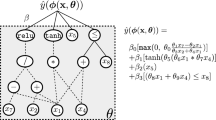Abstract
This work proposes an automatic methodology for modeling complex systems. Our methodology is based on the combination of Grammatical Evolution and classical regression to obtain an optimal set of features that take part of a linear and convex model. This technique provides both Feature Engineering and Symbolic Regression in order to infer accurate models with no effort or designer’s expertise requirements. As advanced Cloud services are becoming mainstream, the contribution of data centers in the overall power consumption of modern cities is growing dramatically. These facilities consume from 10 to 100 times more power per square foot than typical office buildings. Modeling the power consumption for these infrastructures is crucial to anticipate the effects of aggressive optimization policies, but accurate and fast power modeling is a complex challenge for high-end servers not yet satisfied by analytical approaches. For this case study, our methodology minimizes error in power prediction. This work has been tested using real Cloud applications resulting on an average error in power estimation of 3.98 %. Our work improves the possibilities of deriving Cloud energy efficient policies in Cloud data centers being applicable to other computing environments with similar characteristics.
Similar content being viewed by others
References
Adiga, N., et al.: An overview of the BlueGene/L Supercomputer Supercomputing, ACM/IEEE 2002 Conference, pp. 60–60 (2002)
Arroba, P., Risco-Martín, J.L., Zapater, M., Moya, J.M., Ayala, J.L., Olcoz, K.: Proceedings of the 5th International Conference in Sustainability in Energy and Buildings (SEB’ 14) 2014. Accepted, to appear in (2014)
Back, T., Hammel, U., Schwefel, H.P.: Evolutionary computation: comments on the history and current state. Evol. Comput., IEEE Trans. on 1(1), 3–17 (1997). doi:10.1109/4235.585888
Bar-Yam, Y.: Dynamics of Complex Systems. Addison-Wesley stydies in nonlinearity. Westview Press (1997)
Berl, A., Gelenbe, E., Di Girolamo, M., Giuliani, G., De Meer, H., Dang, M.Q., Pentikousis, K.: Energy-efficient cloud computing. Comput. J. 53(7), 1045–1051 (2010)
Bianchi, L., Dorigo, M., Gambardella, L.M., Gutjahr, W.J.: A survey on metaheuristics for stochastic combinatorial optimization. Natural Comput. An Int. J. 8(2), 239–287 (2009). doi:10.1007/s11047-008-9098-4
Blum, C., Roli, A.: Metaheuristics in combinatorial optimization: Overview and conceptual comparison. ACM Comput. Surv. 35 (3), 268–308 (2003). doi:10.1145/937503.937505
Boccara, N.: Modeling Complex Systems. Graduate Texts in Physics. Springer (2010)
Bohra, A., Chaudhary, V.: IPDPSW, pp. 1–8 (2010)
Brandon, J.: Going green in the data center: Practical steps for your sme to become more environmentally friendly. Processor 29(39), 1–30 (2007)
Buyya, R., et al.: PDPTA, p. 2010, Las Vegas (2010)
Chen, Q., et al.: DASC, pp. 768–775 (2011)
Contreras, G., Martonosi, M.: ISLPED, pp. 221–226, New York (2005)
El-Sayed, N., Stefanovici, I.A., Amvrosiadis, G., Hwang, A.A., Schroeder, B.: Temperature management in data centers: why some (might) like it hot. SIGMETRICS Perform. Eval. Rev. 40(1), 163–174 (2012)
Ge, R., et al.: Performance-constrained distributed dvs scheduling for scientific applications on power-aware clusters In: Supercomputing Conference, SC ’05, pp. 34–34. IEEE Computer Society, Washington, DC (2005)
Goldberg, D.E.: Genetic algorithms in search, optimization, and machine learning. Addison-Wesley Professional (1989)
Google Data Centers: Efficiency: How we do it. Temperature control (2014). http://www.google.com/intl/en_ALL/about/datacenters/efficiency/internal/temperature
Hemberg, E., Ho, L., O’Neill, M., Claussen, H.: A comparison of grammatical genetic programming grammars for controlling femtocell network coverage. Gen. Prog. Evol. Mach. 14(1), 65–93 (2013). doi:10.1007/s10710-012-9171-8
Henning, J.L.: Spec cpu2006 benchmark descriptions. SIGARCH Comput. Archit. News 34(4), 1–17 (2006). doi:10.1145/1186736.1186737
Hsu, C.H., Feng, W.C.: Supercomputing Conference, pp. 1–1 (2005)
Kaplan, J., Forrest, W., Kindler, N.: Revolutionizing data center energy efficiency. Tech. Rep. July. McKinsey & Company (2008)
Lewis, A., et al.: HotPower, pp. 4–4, Berkeley (2008)
Markoff, J., Lohr, S.: Intel’s huge bet turns iffy. New York Times Technology Section (2002)
Meisner, D., et al.: ISLPED, pp. 319–324, New York (2010)
Miller, R.: Google: Raise your data center temperature (2008). http://www.datacenterknowledge.com/archives/2008/10/14/google-raise-your-data-center-temperature/
O’Neill, M., Ryan, C.: Grammatical evolution. Evolutionary Computation, IEEE Transactions on 5(4), 349–358 (2001). doi:10.1109/4235.942529
Niles, P., Donovan, P.: Virtualization and Cloud Computing: Optimized Power, Cooling, and Management Maximizes Benefits. White paper 118, Revision. Tech. rep., vol. 3. Schneider Electric (2011)
Pelley, S., et al.: WEED (2009)
Ryan, C., Collins, J., Neill, M.: Grammatical evolution: Evolving programs for an arbitrary language. In: Banzhaf, W., Poli, R., Schoenauer, M., Fogarty, T. (eds.) Genetic Programming, Lecture Notes in Computer Science, vol. 1391, pp. 83–96. Springer Berlin Heidelberg (1998), doi:10.1007/BFb0055930
Scheihing, P.: Data center facilities and engineering conference, Washington DC (2007)
Tibshirani, R.: Regression shrinkage and selection via the lasso. J. R. Stat. Soc. Series B (Methodological) 58(1), 267–288 (1996)
Turner, C.R., Fuggetta, A., Lavazza, L., Wolf, A.L.: A conceptual basis for feature engineering. J. Syst. Software 49(1), 3–15 (1999). doi:10.1016/S0164-1212(99)00062-X
Vladislavleva, E., Smits, G., den Hertog, D.: Order of nonlinearity as a complexity measure for models generated by symbolic regression via pareto genetic programming. Evol. Comput., IEEE Trans. on 13(2), 333–349 (2009). doi:10.1109/TEVC.2008.926486
Warkozek, G., et al.: ICIT, pp. 211–216 (2012)
Warren, M., et al.: Supercomputing Conference, pp. 61–61 (2002)
Author information
Authors and Affiliations
Corresponding author
Rights and permissions
About this article
Cite this article
Arroba, P., Risco-Martín, J.L., Zapater, M. et al. Enhancing Regression Models for Complex Systems Using Evolutionary Techniques for Feature Engineering. J Grid Computing 13, 409–423 (2015). https://doi.org/10.1007/s10723-014-9313-8
Received:
Accepted:
Published:
Issue Date:
DOI: https://doi.org/10.1007/s10723-014-9313-8




